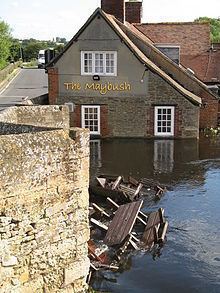Carries A415 road Locale Oxfordshire Material stone Body of water River Thames Heritage status Listed building Piers in water 5 | Crosses River Thames Design arch Location Oxfordshire Carry A415 road Number of spans 12 | |
 | ||
Maintained by Oxfordshire County Council Similar River Thames, Radcot Bridge, Tadpole Bridge, Pinkhill Lock, Tenfoot Bridge | ||
New Bridge is a 13th-century bridge carrying the A415 road over the River Thames in Oxfordshire, between Abingdon and Witney, close to the Thames' confluence with the River Windrush. It is one of the two oldest surviving bridges across the Thames, part Grade I and part Grade II*-listed.
Contents
The bridge is in a rural setting, with a public house at either end: the Maybush Eco Inn on the south bank and the Rose Revived on the other.
The bridge consists of two spans, where the northern span crosses the river and the southern span, south of the Maybush, is dry underneath except when the river floods.
History
The bridge dates from the 13th century and is built of Taynton stone in the same way as Radcot Bridge, which is slightly older. They were built by monks on the orders of King John in order to improve communications between the wool towns in the south of England, and the Cotswold farms, and named "New Bridge" as it was the youngest out of the three bridges built at the time (the third being the Lechlade bridge, replaced in the 19th century). It was also very much longer than it is now, with 51 arches and being 726 yards (664 m) long, compared with the current 12 arches.
Whether New Bridge or Radcot Bridge is the oldest bridge today across the Thames is debatable — Radcot Bridge is older however it was extensively damaged during the Wars of the Roses and had to be greatly rebuilt, furthermore since local reroutings in 1787 Radcot Bridge no longer crosses the main channel of the river.
In 1644, in the English Civil War, the Battle of Newbridge was fought on the banks of the river. Parliamentarian William Waller attempted to cross in order to surround Oxford and capture King Charles, but was defeated.
In 2007 the area was flooded extensively.
Current status
The bridge is controlled by traffic lights, not being designed to carry modern traffic, and an 18-tonne (18-long-ton; 20-short-ton) weight limit is imposed to protect its weakening structure. Further reductions are considered likely by local authorities. According to a 1996 survey, one of the arches is only capable of carrying its own weight, though it was decided that there was enough leeway to allow traffic to continue across the bridge. The likelihood of collapse is considered "slim". Local authorities have decided to enter into negotiations to buy land that could be used to build a new bridge 270 yards (250 m) upriver, believing that this is the only long-term option available. The idea of a new bridge is opposed by local residents of Standlake who would prefer to see the existing bridge remain open for light traffic only.
The bridge has national recognition and statutory protection from alteration.
The northern span is listed at maximal Grade I whereas the southern at Grade II*, the second-highest of the three grades of listing, designating "particularly important buildings of more than special interest".
